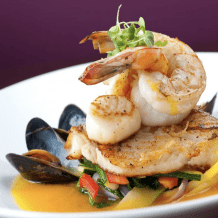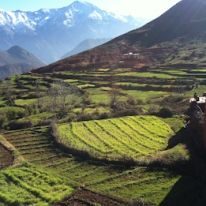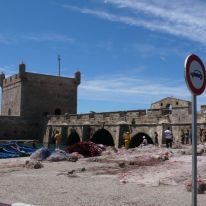
The 9 Best Morocco Family Vacation Ideas Perfect for Summer Travel
Morocco is the ideal destination for a summer vacation if you are searching for a one-of-a-kind travel experience for the entire family. If you are the household trip planner, then you have the option of embarking on a Morocco Family Tour tailor-made to include exploration of various cities and regions of the country along with family-friendly activities or to attempt a self-guided option by 4×4 on your own.
Morocco’s location at the northernmost point of Africa makes it an easy introduction into the African continent and its diverse climate allows travelers options to experience a range of activities year-round. It is possible to ski and head to the beach all in the same day. Our Summertime Travel Guide introduces 9 of the Best Vacation Ideas for Families.
Morocco has sixteen regions and is divided into sixty provinces. Each destination offers to inspire family-friendly touring activities ranging from food and market tours to cooking classes, handicraft design, hiking, trekking, camel trekking, quad riding, sand skiing, and a hot air balloon ride over the High Atlas. Morocco’s sandy beaches, blue jeweled coast, desert dunes, mountain ranges, and historic cities provide families traveling to Morocco an enriching experience.

The 9 Best Morocco Family Vacation Ideas
1. Sahara Desert Family Adventure
The Sahara Desert offers families an unforgettable outdoor adventure. Families who would like to visit the Sahara Desert are advised to start their journey from Marrakech and allow for a minimum of a 4-day timeframe. The ideal family road trip to the Sahara starting and ending in the city of Marrakech will allow for travel down south via the Tizi n’Tichkapassing the geologic region of the Ounila Valley.
The route to Morocco’s desert region is one of the most arresting with its panoramic views of the High Atlas, Berber villages and fertile valleys. A cinematographer’s dream, the earth-toned, rust-colored pise villages dot the landscape and create shadowlike images in the High Atlas. Families interested in sightseeing en route to the Sahara desert should not miss out on a visit to Ait Benhaddou, a UNESCO World Heritage Site. Ait Benhaddou is coveted by film directors around the world. Exploring the Ksar of Ait Benhaddou, the Pacha Glaoui’s Kasbah of Telouet, and the Skoura palmeraie is part of a once in a lifetime family adventure to Morocco’s south. Also recommended for kids and film buffs are the CLA Studio and Cinema museum where sets from various movies such as Kundun and The Last Temptation of Christ are kept.
During your Sahara Desert Family Adventure, you will also pass through the Draa Valley, the Todra Gorge, and make a local stop to have lunch with a Berber family. For family’s who are interested in intensive hiking and magnificent scenery extending your trip to 5 days and carving out time to visit the Dades Valley and Gorge is highly recommended. Just before you reach the Sahara there’s also the opportunity to visit the town of Rissani and learn how their local Berber pizza, called Madfouna is made. A final pitstop for tea at Khemlia’s Berber village where you can experience Gnaoua trance music in the heart of Merzouga is a must-do activity perfect for the entire family.
A direct drive to the Sahara Desert from Marrakech exceeds 9 hours, therefore we recommend a family trip that is not less than 4 Days/ 3 Nights. A Sahara Desert Family Adventure can be broken up to allow for overnight stays in Ouarzazate, the Skoura palmeraie and the long-awaited 1001 Arabian nights desert experience in a luxury camp.

2. Ait Ouzzine Berber Village Discovery
If departing from Marrakech, you can drive along the desert route connecting the Draa Valley (Tansikht) and Rissani and enter the region of N’kob and Aït Ouzzine where you discover a local Berber village and enjoy time with a local family. The peaceful village of Ait Ouzzine is inhabited by over 300 families living in historic kasbahs. Each family maintains its own wheat, alfalfa, and henna fields, water wells, livestock, and gardens. During your visit to Ait Ouzzine Berber Village, you will also have the option to partake in cooking lessons on how to make a Berber tajine and learn to bake traditional mountain bread. Exploration of Ait Ouzzine’s green fields and to learn how the Berbers use their botanical gardens, livestock, and henna plants are just a hint of the unique experiences that await you.
Interested in experiencing a traditional Moroccan beauty treatment? Then have your hands and feet painted with henna by a local village artist; they will adorn your hair with saffron. Take your beauty experience a step further and participate in being doused with Berber perfume: musk, amber, and the village’s own spices are the classic ingredients. Your afternoon will end with mint tea, almonds, then return to your hotel Ouarzazate in time to catch the African yellow sunset.

3. Marrakech’s Oasiria Water Theme Park
Marrakech is well positioned for day trips and that makes it a favorite city to base yourself and explore Morocco, however, summertime is hot. Escape the Red City’s heat in Oasiria, an Aquatic Park located in the outskirts of Marrakech. Oasiria has numerous slides at varying speeds and lengths, perfect for both children and adults. There is also an on-site fitness club and Africa’s first aqua rock climbing wall where your fall is designed to drop you into a giant swimming pool. Post-workout, stroll through Oaseria’s 10-hectare garden and explore olive tree orchards and 500 species of botanical and medicinal plants. For lunch or dinner choose between one of the four open terrace restaurants. The menus offer family friend options ranging from burgers to pizza along with salads and a local daily tajine.

4. Coastal Bliss & Bird Watch in Oualidia at a Lagoon
A recommended 2-3 day excursion from Marrakech for families in search of coastal bliss and bird watching is the Oualidia lagoon. Oualidia is located between the beach town of El Jadida and the fisherman’s port of Safi. The region of Oualidia is also an important ecological location and an excellent choice for serious bird watchers or nature lovers. Oualidia is loved by in-the-know ex-pats and Moroccans for its natural beaches, marshes, and wetlands. Bird lovers can look forward to spotting curlews, flamingos, sandpipers, plovers, Little Grebe, Oystercatcher, the Black-winged Stilt, the Yellow-legged Seagull, Grey Plovern, the Greenshank Curle and other migrating birds. The area has a temperate year-round climate. The best time for bird watching is in spring or summer.
An added bonus of visiting Oualidia in the summertime is that it is an off the beaten track location. Summers are not as crowded compared to the other beach towns like Essaouira and El Jadida. Oualidia offers a low key, relaxing environment and is a great place to unwind with a book, hike along cliff paths and deserted grottoes, or kayak around the lagoon. Stay for an afternoon or spend the night at the on-site at the 5-star boutique hotel La Sultana Oualidia or Hippocampe Hotel. Regardless of if you are in town for a day or overnight, don’t miss out on dining at Ostrea II, a seafood restaurant that offers the region’s specialty, oysters, crab, and lobster along with other local catch of the day.

5. Trek across the Dades Valley & Gorge or Explore by Car
Morocco is a country with varied terrain. A trek across the Dades Valley & Gorge is recommended for active families who are fit and would like to experience rocky terrain along with spectacular geologic views. A trek throughout the region of the Dades Valley will take you through a region that boasts limestone cliffs with uniquely shaped erosions and superb scenery. Depending on the season you will trek across fertile fields, riverbanks and see several fortified ksours. At the bottom of Gorge of Boumalne Dadès there are ruined hilltop Kasbahs and valley floor gardens.
For families who want to explore the Dades Valley region by car, the start is in Ouarzazate. This route will take families through Skoura, a 12th-century fertile oasis designed by lmohad Sultan Yacoub el-Mansour. It is lined with immense palm groves and offers great views of the Atlas Mountains and deserted landscapes, and you will see Todra Gorge, a gigantic rock famous for the ability to change colors without sunlight.
By car, you would continue passing through the Valley of Roses, also known for its annual rose festival. The first festival started when the French brought over the Damask rose. Nowadays there are Capp et Florale distillation factories laid out in the small Kasbah town, they manufacture the entire nation’s products of Eau de rose. After shopping, the scenic road awaits you. Other highlights of the car trip into the Dades Gorge Valley include seeing the Dades River and Imini River; they flow from the High Atlas Mountains southeastward to Tagounit and from Tagounit mostly westwards to the Atlantic Ocean. There are also guesthouses en route where you can eat and enjoy views of the Dades Gorge.
6. Excursion to Ait Ashok, Ourika Valley’s Hidden Berber Village
The Berber Village of Ait Ashok is the perfect day trip from Marrakech for families looking to hike and picnic. Ait Ashok is one of the top hiking and picnic destination for active families. The Ouirka Valley can get crowded with tourists during peak season, but the charming Berber village Ait Ashok, is a secret gem where a peaceful hike can be enjoyed year-round. This secret paradise has unforgettable views of the Atlas Mountains and small farming villages. Trekkers can have lunch with a local Berber family in an auberge with views. Depending on the time of year, you will see harvests of walnuts, almonds, apples, and other fruits.

7. Craft making in Fes: Leatherwork, Bookbinding, Brass Design, Drum Making
Morocco’s souk culture will expand your definition of what it means to shop. All of Morocco’s imperial cities and even villages have souks specializing in something. Souks are sectioned off into quarters and you can buy everything from sheepskin, leather goods, groceries at the outdoor food market, exotic spices, rugs, textiles to make your own garments, essential oils at pharmacies and everything in between; the most famous souk is in Fes, the fourth largest of Morocco’s cities.
Visitors from around the world come to explore the labyrinth-like medina of Fes and witness the famous Dyer’s market, Tannery, and the Weaver’s Cooperative. All three areas have preserved the traditional methods of making their crafts. At the Dyer’s market, families can see the century-old vats that have been used to soak animal skins and produce luxury goods. The Tannery continues to produce some of the best leatherwork in Morocco, and the Weavers specialize in making the finest silk fabrics for Jellabas. Local purchases for the entire family can be made along with special orders if you are interested in leather jackets or other goods.
The art of Moroccan Craftmaking in Fes is available to families interested in participating in a workshop. Local craft-making workshops offer 4-hour hands-on sessions whereby children can learn how to emboss leather, bookbinding, make a brass tray, or an African drum. An example of a family-friendly workshop highly recommended is to learn how to make a leather-bound journal. This type of workshop will cover the techniques of crafting your very own Leather journal – complete with long stitches and a variety of Manila papers! The workshop will guide you through the step-by-step technique to craft your own handmade leather journal with long stitches. Materials, such as leather, thread, paper, and others, will be provided on the day of the workshop. This workshop also provides techniques on chiseling and stamping on leather to create unique covers for sketches or notebooks.
8. Fes Festival of Sacred World Music
For the past twenty-four years, the Fes Festival of Sacred Music has contributed to maintaining a dialogue with the sacred through its most famous forum and highlighting of arts and music. The 10-day festival is held in mid-summer annually and aims to bring together scholars, artists, musicians, families, Moroccans, and visitors from abroad. With roots in spiritual values, the festival serves as an anchoring ground to teach people to learn to appreciate different cultures and communicate better with one another.
In addition to bringing attention to various cultures, the Fes Festival has been a wonderful tool in raising awareness for Moroccan culture. During the day, visitors can explore Fes’ medina, souk, and mosques or take part in seminars or round table discussions covering the festival theme. In the afternoon, evening, and late-night, there are concerts given by performers arriving from every angle of the globe. These musicians help celebrate the musical spectrum of European classical, Sufi ritual songs, trance music, Arab-Andalusian rhythms, a Bulgarian orthodox choir, Hindustani chants, Celtic sacred music, Christian Gospel, Swedish chamber choir, Pakistani Qawwali incantations, Egyptian madhi odes, flamenco-style Christian saeta, ancient Indian gwalior chants, and Turkish whirling dervishes.
Ever since its inception, this event has witnessed growing success. In 2001, the UNO declared the Festival as one of the most outstanding events that are contributing to the dialogue of civilizations.

9. Explore Chefchaouen, the Storybook Blue City
Exploring Morocco on a family adventure would not be complete without visiting the Storybook Blue City Chefchaouen. Set in the northernmost point of Morocco, Chefchaouen is in-between Tetouan – Morocco’s Little Jerusalem – and the Rif Mountains. Chefchaouen is famous for its blue-painted houses and local goat cheese. Historically, the town’s former population was Jewish. After the Spanish Reconquista of medieval times, many Jews sought refuge in this mountain city. Chefchaouen was also used as a fortress by Moulay Ali Ben Moussa Ben Rached El Alami to fight off the invading Portuguese who were entering Morocco from the North in 1920; the Spanish seized Chefchaouen to form part of Spanish Morocco. Families interested in Spanish history will enjoy learning about Andalucia’s connection with this part of Morocco.
Beyond Chefchaouen’s charming architecture, the town is ideal for a low key hike, to kick back and read a book, and shop for native handicrafts that are unique to this Northern Moroccan town. Chefchaouen offers a nice array of locally woven items such as wool blankets made with the regional colors of red, white and blue. You can also find local artisans who sell hand-painted furniture, local pottery made with terracotta, and antique jewelry. Chefvhaouen’s name means “look at the horns”, referring to the shapes of the mountain tops that tower over the town and look like the two horns (chaoua) of a goat. Not surprisingly goats are in abundance in this area and the cheese native to Chefchaouen is said to be some of the tastiest in all of Morocco.
For more information about Popular Family Tours or Things to do With Kids in Essaouira





